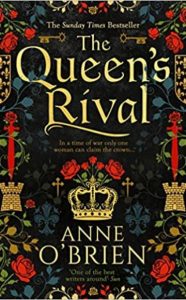Silent Witnesses: Writing About Medieval Women
 – ‘Name Six English Queens.’ –
– ‘Name Six English Queens.’ –
Faced with this question at a Pub Quiz Night, most teams would make a fairly accurate stab at it. Elizabeth I. Bloody Mary. Queen Victoria. Elizabeth II. A guess at the wives of Henry VIII, beginning with Anne Boleyn.
Not one of them a medieval English queen.
Why is it that so many of these wives of our early English kings have remained almost invisible, while the sins or exploits of their husbands are legendary? King John is notorious but few would claim to know much about Isabelle of Angouleme. Richard II, brilliant, usurped, and tragic, yet Isabelle de Valois hardly makes a mark. Edward I, Hammer of the Scots, built castles and led his armies. Who can relate more than the basic facts about Eleanor of Castile other than the romantic tale of Eleanor Crosses erected by her grief-stricken husband, which probably says more about Edward than about Eleanor.
Were these medieval women, and those of the aristocracy, so lacking in authority, in influence, or even in intelligence that they should become anonymous, a mere footnote on a page? Were they uneducated, fit for nothing but to be decorative witnesses to the daring or desperate ventures of their husbands? The impression is that medieval women of the aristocratic class remained solar-bound, waiting for their men-folk to return from war, plying a needle as they sang and prayed and gossiped in a feminine world. We are led to believe that they had nothing to say about what they and their regal husbands were doing.
Yet how could they be mere onlookers, intelligent and well educated as many of them undoubtedly were, with no opinion of the people and the political goings-on around them? How could they not be well informed and vocal about the tribulations that often threatened to destroy their lives and those of their loved ones.
The answer is simple enough. They are rendered silent because they lived in a man’s world, written by men, about the feats of men. Women are rarely given a voice, not even royal women, except for the very few, such as the infamous Eleanor of Aquitaine whom it was difficult to silence, yet even she was incarcerated by an enraged Henry II for stirring rebellion amongst their sons. Women are recorded for us in their relationships with men: a daughter, a sister, a wife, a cousin. Thus our medieval women are skeletons without flesh, two dimensional in their lack of character, without even a physical description since medieval portraits are rare.
As Virginia Wolfe once said: ‘For most of History, Anonymous was a woman.’ For this reason, I decided to shake the cobwebs from some of these medieval women of interest and allow them to take the stage, three-dimensional and with much to say.
Here they are:
Anne Neville, daughter of Warwick the Kingmaker, a pawn in the game of marriage and power-brokering, but from a family not notable for its silence. Alice Perrers, ambitiously scheming mistress of King Edward III, but also a smart business-woman. Katherine de Valois, a naive political bride for Henry V who managed to snatch some happiness when she found the strength to take Owen Tudor into her tragic life. Katherine Swynford whose liaison with John of Gaunt was not a light-hearted love affair, but a scandal of sinful proportions. Elizabeth of Lancaster, dragged into the depths of treason by her marriage to John Holland, thus her husband set in conflict against her brother the King. Joan of Kent, notable for her clandestine marriages, but worthy of so much more in the manipulation of power.
Elizabeth Mortimer, forceful wife of the infamous Hotspur. Invisible Queen Joanna of England and treacherous Constance of York, both women of some reputation. Cecily Neville, doyenne of the Wars of the Roses, must of course take a bow upon the stage. And now, in my present writing, the women of the Paston family who allowed us to see so much of their lives and their menfolk through their letters.
How much these women have to say, about their lives and their motivations, their ambitions and those of their families, when given the opportunity to do so through the pages of historical fiction. They are there, with all their admirable strengths and shocking weaknesses, to be discovered through patient research.
And the result for us? We are offered the opportunity to rejoice and suffer with them through their happiness and tragedy. We understand the power and privations for medieval women. Their skeletons are clothed for us with flesh and garments and appropriate jewels. They display their talents and preferences; they laugh and sing and engage in clashes of temperament; they argue; they weep and mourn as they suffer heart break; they are driven by bitter revenge.
It is my purpose in writing historical fiction that these medieval women should be allowed to step out of the pages, to keep company with the reader and come alive. They are no longer a tiny footnote, to be overlooked or ignored in preference to their men-folk. They can never again be swept behind the arras of history.
They are silent no longer.
—
Sunday Times Bestselling author Anne O’Brien was born in West Yorkshire. With a BA Honours degree in History at Manchester University and a Master’s in Education at Hull, she lived in East Yorkshire for many years as a teacher of history. Today she has sold over 700,000 copies of her books in the UK and internationally. She lives with her husband in an eighteenth-century timber-framed cottage in the depths of the Welsh Marches in Herefordshire, an area providing endless inspiration for her novels about the forgotten women of history.
Follow her on Twitter https://twitter.com/anne_obrien
Find out more about her on her website https://www.anneobrienbooks.com/
THE QUEEN’S RIVAL
 England, 1459: Cecily Neville, Duchess of York, is embroiled in a struggle to topple the weak-minded King Henry VI from the throne. But when the Yorkists are defeated in the fiasco at the Battle of Ludford Bridge, Cecily’s family flees and abandons her to face, alone with her young children, a marauding Lancastrian army.
England, 1459: Cecily Neville, Duchess of York, is embroiled in a struggle to topple the weak-minded King Henry VI from the throne. But when the Yorkists are defeated in the fiasco at the Battle of Ludford Bridge, Cecily’s family flees and abandons her to face, alone with her young children, a marauding Lancastrian army.
Cecily can only watch as their lands are stripped and divided up by the ruthless Queen Marguerite. Her men-folk are attainted for treason, the Duchess is placed under restraint. What will the future hold for her? Cecily begins to spin a web of treason and deceit – one that will eventually lead to the fall of King Henry VI, and to her eldest son being crowned King Edward IV.
This is a story of heartbreak, ambition and treachery, of one woman’s quest to claim the throne for the House of York during the violence and tragedy of the Wars of the Roses.
‘Vivid, thrilling, layered, stylish, The Queen’s Rival is a brilliant read.’
Carol McGrath, author of The Silken Rose
‘A compelling story of divided loyalties and family betrayals. Dramatic and highly evocative.’
Woman&Home
‘with a clever format of letters, interspersed with Chronicle newspaper reports, O’Brien manages to reinvent historical fiction by thrusting an untold story into the spotlight. A relatable protagonist, this could easily be a modern-day story of a courageous woman with a strong mind, making good’.
My Weekly
‘Dramatic and highly evocative.’
Woman’s Weekly
BUY HERE
Category: On Writing

























Thank you for giving these women a voice, Anne. Mostly they are a footnote, a legacee, a shadow on the landscape through their medicinal gardens or a name in a parish record. I share the same fervour for the women of the British Civil War. I really enjoyed The Queen’s Rival, and am looking forward to your interpretation of the Paston letters.